Why customer identity is essential to stay ahead in a shifting digital landscape
Learn how customer identity enables businesses to build stronger customer relationships using first-party data.
Mar 1, 2022
By Cynthia Goldsworthy
As third-party cookies fade into the sunset, first-party data is emerging as a viable alternative for businesses seeking to gain greater insight into their customers. By connecting and merging first-party data points into customer identities, brands are realizing that a Customer Data Platform (CDP) allows them to gain a more complete and expansive view of their customers.
By the end of 2022, third-party data collection will no longer exist as Google and other search giants end the practice due to consumer demand for increased privacy. By rendering the cookie obsolete, businesses will no longer have access to information they once relied on to track the online behavior of customers and prospects. This requires new strategies for connecting with consumers.
However, the good news for companies is that first-party data is emerging as the bellwether for enhanced customer experiences. Customer data that is obtained directly by visiting a website or downloading a mobile app can help businesses provide more personalized interactions that lead to increased customer engagement.
To find out how, we recently sat down with Gerry Murray, IDC's Research Director, to get his take on the topic. He explains how using a CDP to gather first-party data not only provides an opportunity for businesses to deliver more value to customers, it also allows businesses to get more value from customers. Let’s dive in.
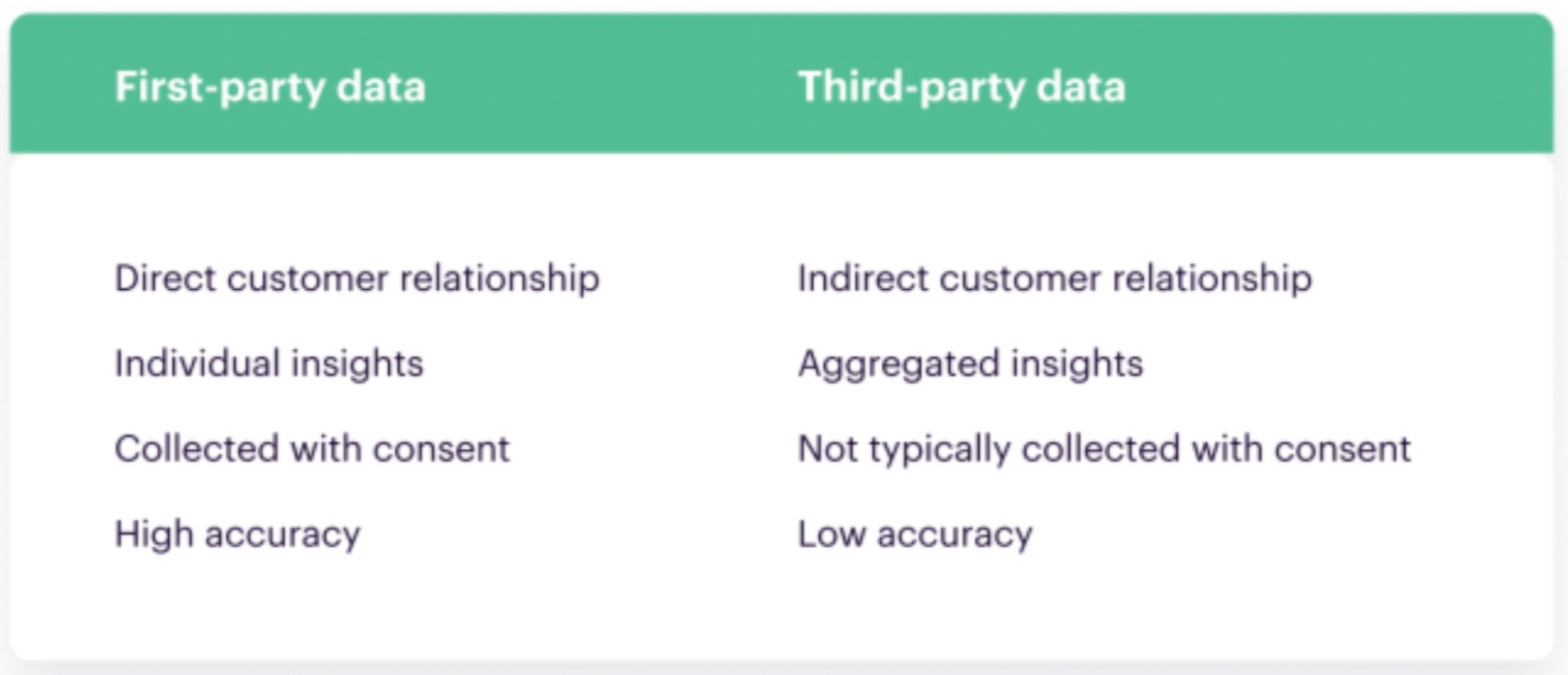
How we got to where we are today
Over the past two decades big changes have occurred with respect to the digitization of our economies and our relationships with customers. It started with the internet and the ability to track customers in terms of the web pages they visited.
Next, social platforms emerged, where marketers could connect people to their friends and family and their professional networks. Then, mobile platforms exploded and became a global phenomenon around 2007, with the iPhone, and beyond that for the next decade. It was the Wild West of data, largely built on the idea that consumer data was a commercial entitlement.
Unfortunately, due to bad practices, hacks, leaks, and discovery that there was a lot more data collection going on than people understood, a backlash rightly occurred.
This led to a significant mindset shift, as well as a culture shift on the buy side of every advertising market with respect to data relationships. As a result, legislative action has been taken all over the world to increase customer privacy.
Industry action has also been taken with respect to customer privacy. There’s been a major mindset shift around customer data and how it’s collected. This action was taken with respect to changes in third-party cookies and how Apple, Google and others are changing the settings in their mobile identifiers.
Top technology challenges for sales and marketing
What’s clear is that these changes are making sales and marketing teams take note.
When IDC asked marketers and B2B sellers what the top technology challenges will be in the coming years, identity, privacy, and consent management topped the list followed by data governance and compliance. Application integration and attribution analytics were also key factors. Because these issues are interrelated, it’s important for businesses to have a more holistic view of the customer and “act as one” across all the customer acquisition activities being conducted.
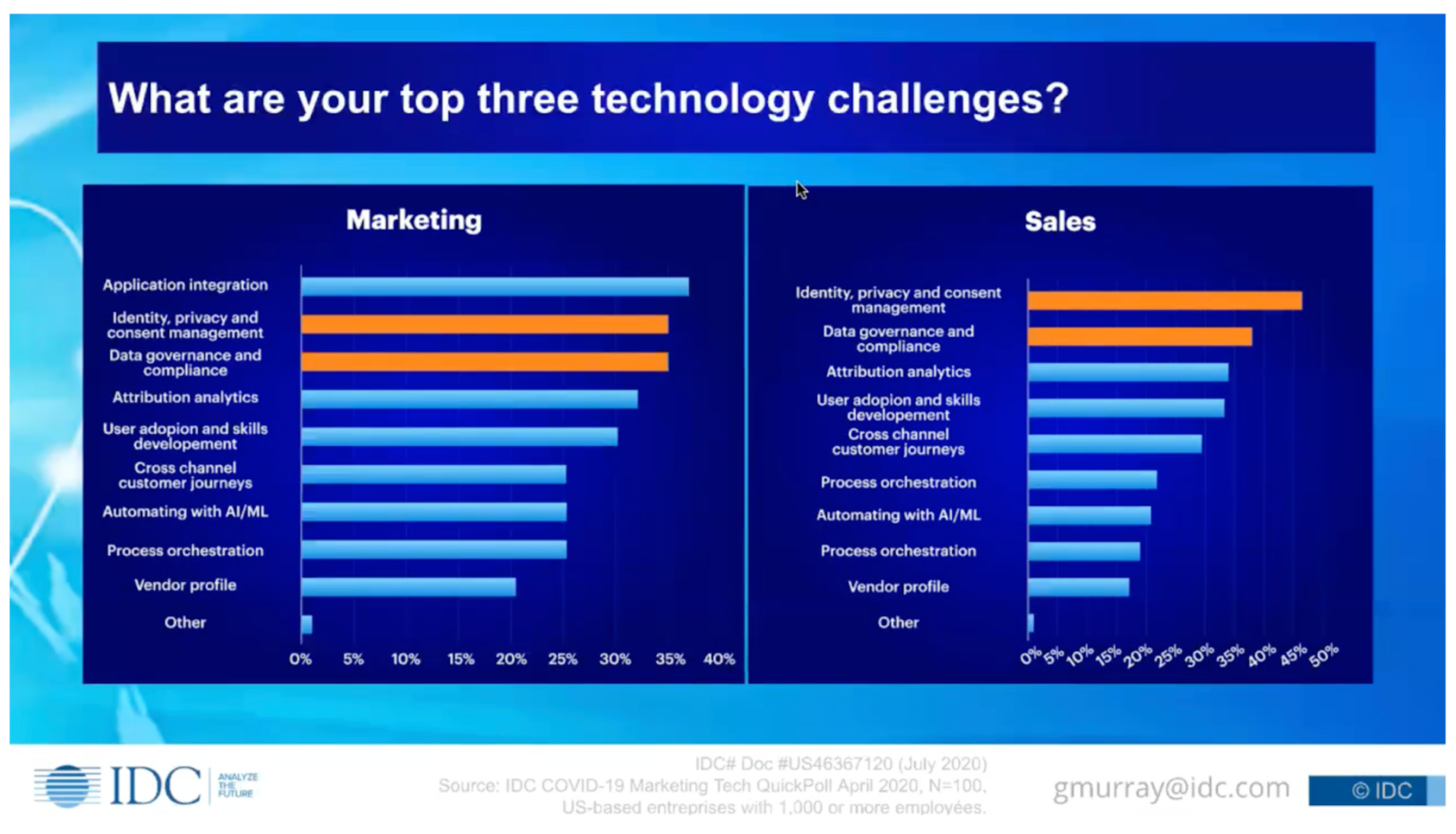
Two big impacts for customers and businesses
As a result of the shifting digital landscape where third-party data is no longer king, two key issues are impacting customers and businesses.
#1: Brands need new methods to manage the identity, consent, and personalization relationships with their customers
Marketers need to make technology changes, to re-architect the backend. The next step can’t be to just put a tech stack in as an island of automation. Everything has to be connected.
#2: Buyers have new expectations about their data relationships with brands
Customers are expecting different relationships with marketers. This is why brands need new methods to manage the identity, consent, and personalization relationship with customers. Individuals want to know how their information is being collected and used.
Hierarchy of expectations of customer experience
According to Gerry, marketers can establish stronger customer relationships by understanding the hierarchy of expectations. While there are foundational elements that need to be made, there is a big opportunity to change the nature of your brand value to customers.
It’s important to note the value of customer identity and how a CDP empowers marketers by providing a more comprehensive customer view. Identity resolution software attributes customer behavior and interactions with your business — across all touchpoints, platforms, or channels — to a single unified customer profile. It allows any team across your organization to access this profile and use it to better serve each customer.
The first four stages of the hierarchy pyramid: identity, personalization, recommendations, and continuity are supported by core CDP features which include data aggregation, data analytics, data activation, and cx ops. We'll take a detailed look below.
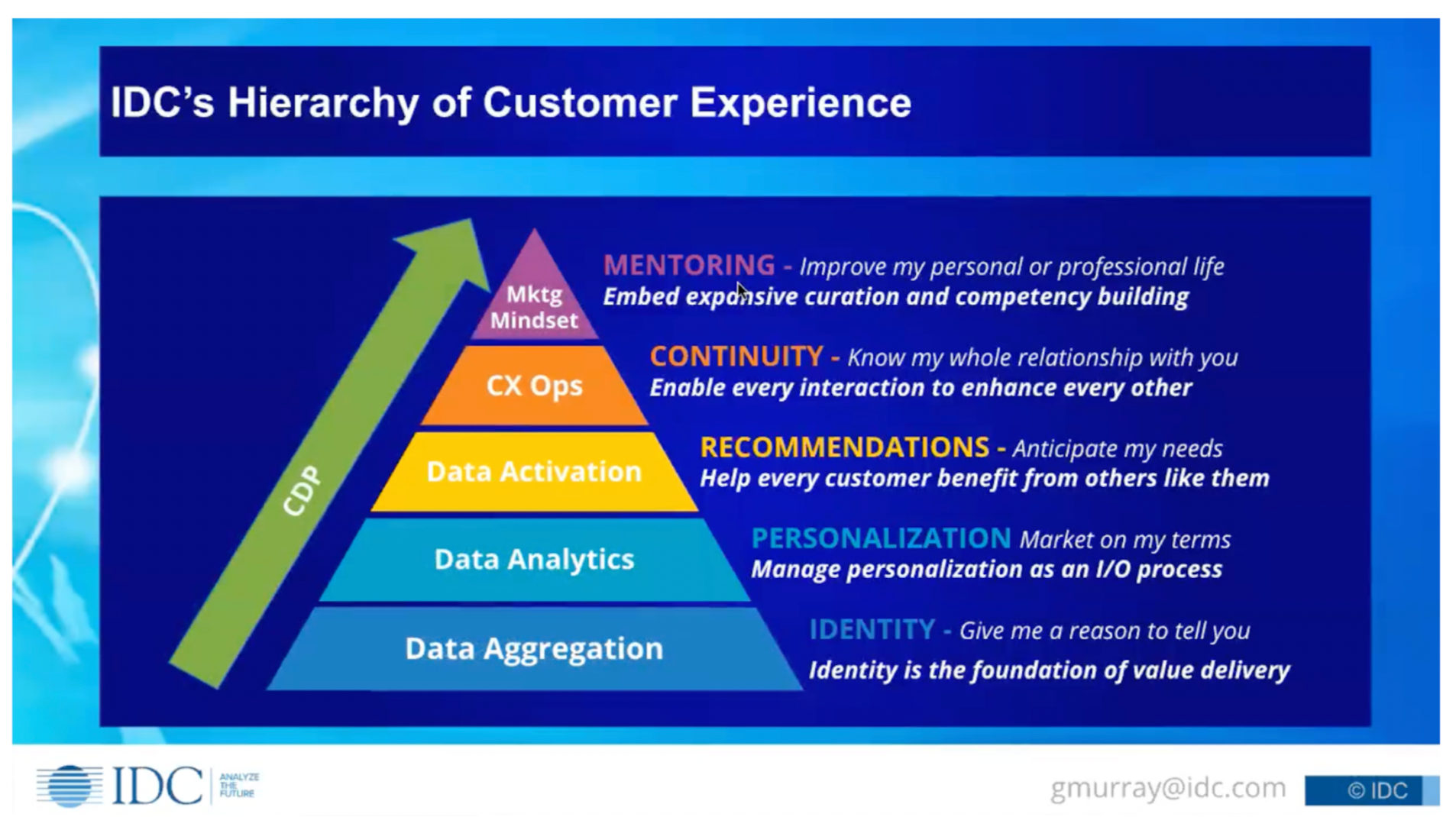
Identity & Data Aggregation: From the customer's point of view, they're asking you to give them a reason to tell you about themselves. It's no longer free data. Marketers have to deliver value into the relationship in order to get the data back from customers. You want to ensure you have their identity consistently defined around all the interactions you're conducting with them. A CDP helps with identity by aggregating data from all the different touchpoints so marketers have a clear picture of customer identity.
Personalization & Data Analytics: As marketers, a lot of effort is put into personalizing the content sent to customers. We're being asked to personalize the data. There are opportunities for changing how we collect data, to become more transparent, that enables the customer to be more participatory in how, why, and when they're disclosing information to you. A CDP allows marketers to place a layer of analytics on top of customer data so we can better personalize the information sent to customers.
Recommendations & Data Activation: Customers want marketers to anticipate their needs. They want you to help them learn from the collective experience of other customers. A CDP enables marketers to anticipate which services customers want or which products to recommend by activating data received in real-time across a diverse set of customer interactions.
Continuity & CX Ops: The customer experience is also about recommending next steps of the customer process and doing so in a real-time interaction. When a customer finishes watching a video, they can automatically go to the next. Or when they click on a web page, they can be given a recommendation for the next place to go to learn more about your solutions. A CDP provides this capability by handling the aggregation, analytics, and activation layers of the infrastructure while providing continuity across all customer interactions.
Mentoring & Marketing Mindset: Marketers are intermediaries between your brand and buyers in the marketplace. Mentor marketing is where you deliver more value. If you're a retailer and you're sending daily emails to your subscription list and you’re only pitching products, very few people are going to be buying from you every day. Instead, in some emails, point buyers toward articles that will interest them — things that still represent the value of your brand but don't focus on making an immediate sale.
Building the backend architecture
Here’s where we look under the hood. Instead of replacing all the frontend engagement applications that marketers have invested in over the years, think about re-engineering the backend to be the connective tissue across those data silos and application environments.
CDPs were originally tuned for marketing applications but are now used for every customer-facing function in the business including sales, communications, finance, shipping, service, and support. Each department acquires different attributes of the customer relationship that can influence activity going on around all the other interactions.
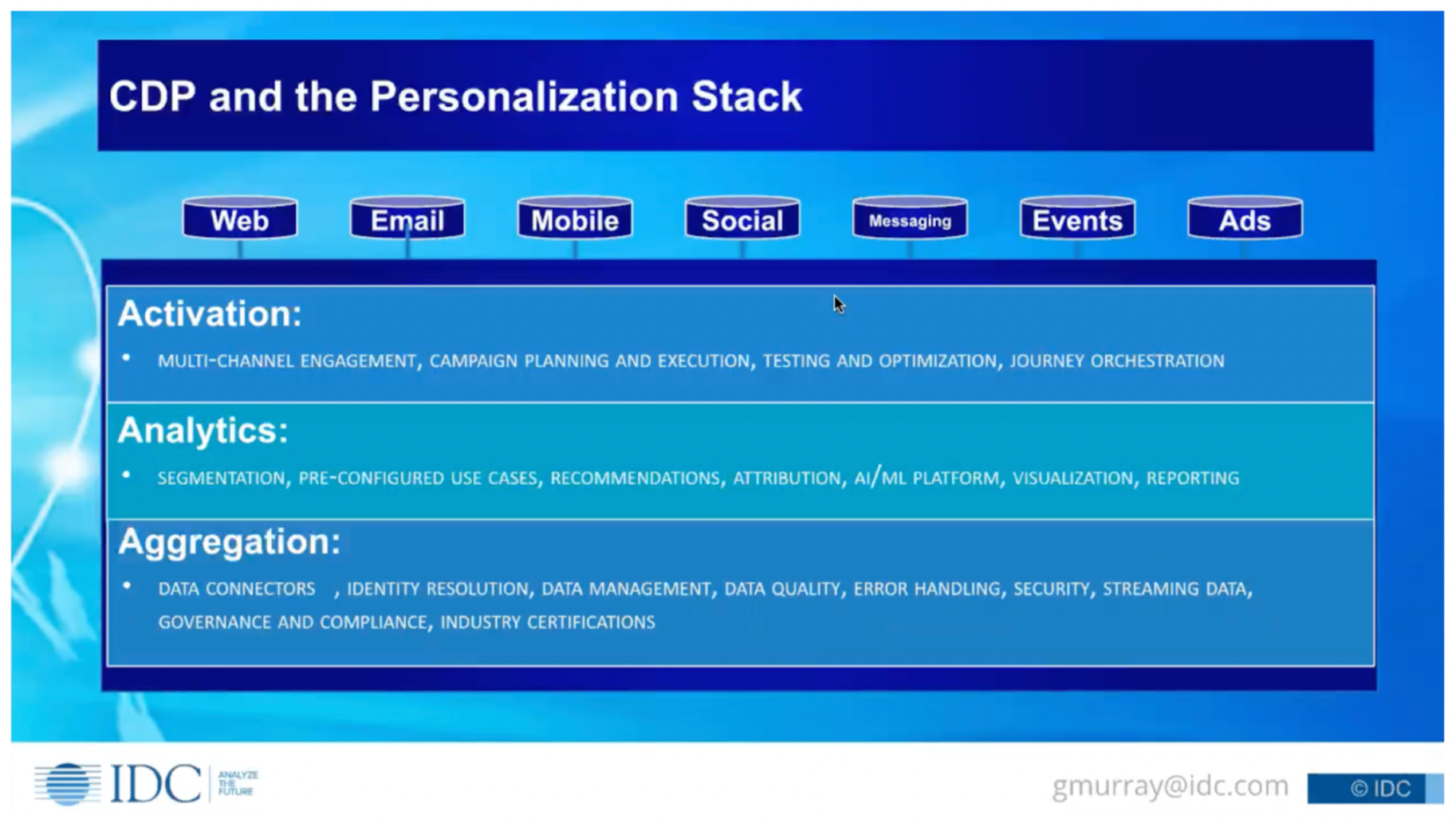
Marketing is more dependent on insights related to all the other downstream interactions within a business. Many of those other functions are about what happens in marketing. If someone calls a contact center to complain about a product, after marketing has already loaded their name on their million-list email server, you don't want to send them the “happy customer, buy more stuff from us” email right after they make a complaint.
The better plan is to move the data about that complaint from the contact center to the marketing server (the email server), and find their name and suppress them out of the list. Or change the nature of the content they’re being sent. Send them the “we’re sorry and we’re working on the problem, and we'll let you know what happens next” email.
The data layer of the infrastructure is the fastest and most responsive part with respect to how customers bounce around all these interactions. But marketers need the stack of capabilities to be as broadly applied across all business use cases in order to do that.
Wrap up: basic principles for marketers
Below are three basic principles regarding customer data and customer identity.
Infrastructure: At the infrastructure level, customer data must become an enterprise service and not just a department resource. Eliminating data silos and connecting data is crucial. It all has to be connected: connected data and connected use cases.
Operations: Every interaction in a business can enhance every other interaction. How can you get the email marketer to talk to the accounts receivable person for a better customer experience? A customer might have late payment status or contract expiry status. That’s good information for an email marketer to use for targeting so they send the right content.
Mindset: There are definite mindset shifts marketers need to make. How you treat customer data is how you treat your customer. Marketers need to move from a commercial entitlement data ownership mode into a data stewardship mode, where data is used not just to drive individual team KPIs, but to deliver more value and higher outcomes for customers.
The State of Personalization 2023
Our annual look at how attitudes, preferences, and experiences with personalization have evolved over the past year.
Get the report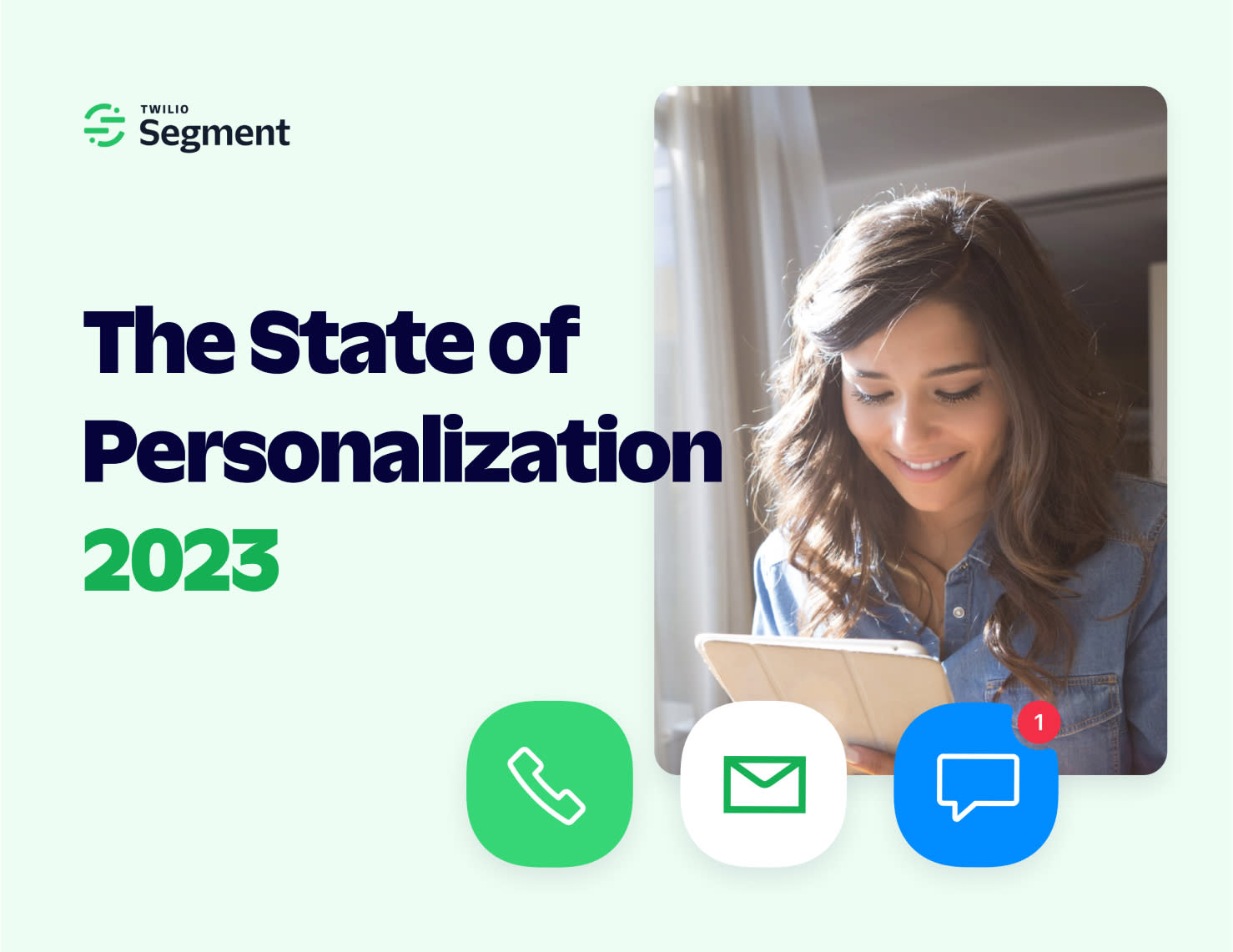
The State of Personalization 2023
Our annual look at how attitudes, preferences, and experiences with personalization have evolved over the past year.
Get the report
Share article
Recommended articles
A Guide to Data Integrity
Big data is a big deal to manage. And data integrity is vital for business growth and customer trust. Learn what it is, why it’s crucial, and how to ensure it.
3 signs your enterprise needs a CDP
Three common warning signs that your enterprise needs a Customer Data Platform
5 Commonly Asked Questions about Twilio Segment
Curious about CDPs? Here's the 5 most commonly asked questions about Twilio Segment.